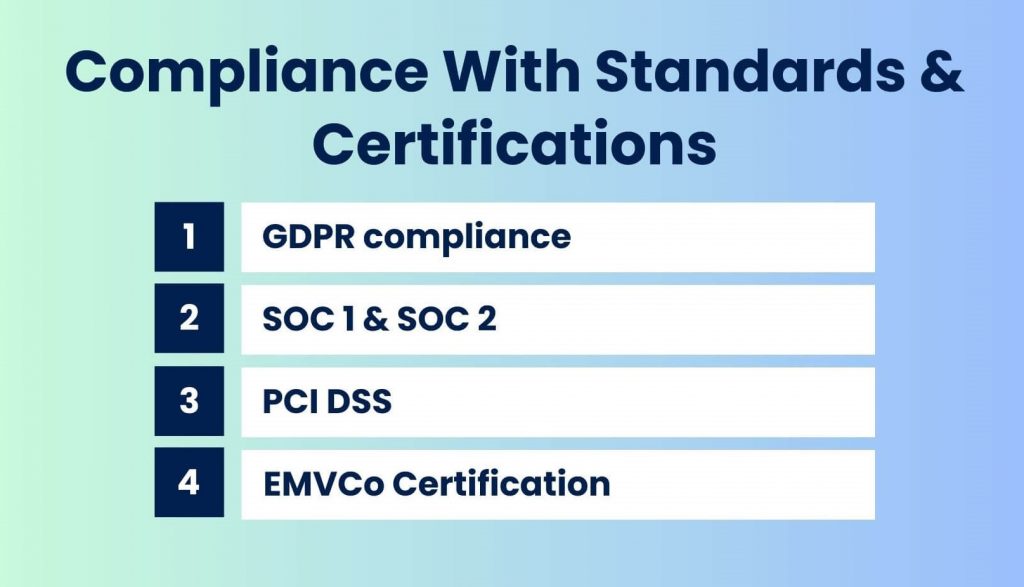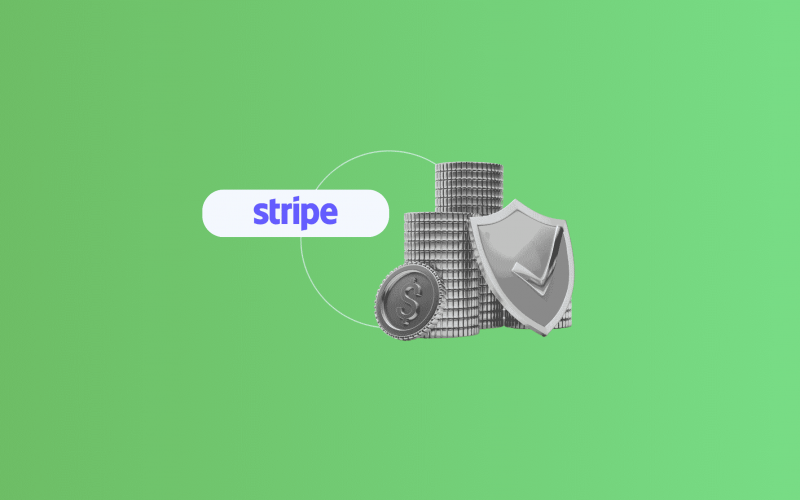Many business owners overlook payment processor security while they shouldn’t. With the US responsible for a staggering 42% of global ecommerce fraud by value, ensuring your payment systems are secure isn’t just smart—it’s essential.
If you use Stripe as your payment processor and wonder, “Is Stripe safe?” we’re here to explore this topic. With mixed reviews out there, let’s pull back the curtain and dive into Stripe’s security measures, compare it to other payment systems, and explore its compliance standards and certifications.
Key takeaways:
- Stripe uses security measures like encryption (SSL and AES-256) and tokenization to secure sensitive data. All transactions occur over a HTTPS network, reducing vulnerabilities.
- Stripe is certified as PCI DSS Level 1, SOC 1, and SOC 2 compliant, which indicates demonstrating adherence to the highest industry standards. It also conforms to GDPR for data protection and ensures safe international data transfers using SCCs.
- For user account protection, Stripe provides features like two-factor authentication (2FA), encryption for API keys, and regular audits.
Contents
Security measures analysis
Why do payment processor security measures matter for your business? They play an important role because your customers trust you with their sensitive information, and that trust is priceless. Strong security measures protect their data—and your reputation—from breaches and fraud. They also help you dodge costly fines, chargebacks, and compliance issues with regulations like PCI DSS and GDPR.
But if you’re responsible for the security measures in your company, then in the case of payment processors like Stripe you cannot blindly trust that they are safe. So, how secure is Stripe? To find out, let’s dive into the core security measures Stripe uses to protect your finances and transactions:
- Encryption;
- Tokenization;
- Data protection;
- Communication security;
- Global registrations and licenses.
These factors are the backbone of Stripe’s safety standards, so let’s break them down one by one.
1. Encryption
Encryption is like a digital vault, locking down data so only the right people can access it—essential for secure transactions. Stripe goes all out, using industry-standard encryption to keep sensitive info safe during every payment process step. One of its top tools? Secure Sockets Layer (SSL) encryption, shields data flowing between the customer’s browser and Stripe’s servers to keep payment details locked up tight.
On top of that, Stripe employs AES-256 encryption, one of the strongest out there, to protect transaction communications. This powerhouse encryption standard offers tough protection, although no system is immune to brute-force attacks.
2. Tokenization
On top of encryption, Stripe steps up security with tokenization, swapping out sensitive payment info for a unique identifier, or “token”, during transactions. This token is useless to anyone but Stripe, making data theft a tough feat.
A heads-up, though: Stripe’s tokens are single-use, so if businesses offer customers to store card details for future transactions, they’ll need other secure methods in place—which can raise a few extra protection considerations.
3. Data protection (PCI DSS)
Stripe doesn’t leave things to chance when it comes to data protection. It meets the strictest standards, including the PCI DSS (Payment Card Industry Data Security Standard), which sets the rules for handling cardholder info safely.
How does it work?
- Secure networks: Companies like Stripe must use firewalls and strong passwords to keep systems safe.
- Protect card data: Card information must be encrypted (made unreadable) when stored or sent over the internet.
- Prevent vulnerabilities: Companies must protect their systems from viruses and keep software up-to-date.
- Limit access: Only authorized people should have access to sensitive card data.
- Monitor activity: Businesses must track and test their systems to catch any security issues quickly.
- Security policies: Companies need clear rules to ensure everyone knows how to keep data safe.
As a PCI Level 1 Service Provider, Stripe is in the top tier of data security, showing serious commitment to keeping customer data safe.
And here’s why PCI DSS compliance matters: Non-compliance can lead to hefty fines from card brands and payment processors. So, Stripe needs to avoid storing card details improperly and keep their standards high.
4. Communication security
When it comes to data transmission, Stripe doesn’t take chances. It uses a technology called Transport Layer Security (TLS) to scramble data so no one else can read it while it’s being sent between Stripe’s servers and other systems. This keeps communication safe from hackers or unauthorized access.
Stripe also makes sure that all connections happen through secure web addresses (HTTPS). On top of that, it uses an extra safety feature called HTTP Strict Transport Security (HSTS), which forces browsers to always connect securely. These measures work together to keep your data safe and private.
5. Global registrations and licenses
Partnering with licensed, well-registered payment providers is key for businesses to stay compliant and secure—and Stripe checks all the boxes. With licenses in 46 countries, including big markets like the US, UK, and Canada, Stripe operates legally and securely worldwide, ensuring full compliance with local regulations. For international entrepreneurs, Stripe goes even further with its “Stripe Atlas” service, making it easy to incorporate US businesses and tap into the US market.
Compliance with standards & certifications
Stripe ensures compliance with industry standards and regulations to secure merchants and customers data. These regulatory standards help reduce exposure to data leaks, scams, invasions of privacy, and other significant issues. Let’s delve into the main standards and certifications.

1. GDPR compliance
With the EU’s General Data Protection Regulation (GDPR), data protection and privacy are top priorities for businesses everywhere. Stripe follows GDPR rules closely to meet its strict standards. Here’s how Stripe ensures compliance:
- Data processing agreement (DPA): Stripe offers a comprehensive DPA that outlines its data protection obligations and responsibilities, ensuring compliance with GDPR requirements.
- Privacy Center: Stripe’s Privacy Center breaks down how it collects, uses, and protects data, promoting transparency and accountability every step of the way.
- Data subject rights: Stripe makes it easy for users to exercise their rights under GDPR, from data access and rectification to erasure.
- International data transfers: Stripe uses Standard Contractual Clauses (SCCs) and other safeguards to ensure data transfers outside the EU comply with GDPR.
2. SOC 1 & SOC 2
Stripe goes the extra mile with regular SOC 1 and SOC 2 audits conducted by independent auditors. These audits provide crucial assurance: SOC 1 validates Stripe’s financial reporting controls, while SOC 2 confirms the confidentiality, integrity, and availability of customer data. It’s Stripe’s way of proving their commitment to secure and reliable service.
3. PCI DSS
Stripe has achieved the ultimate in payment security—PCI Service Provider Level 1 certification, the highest standard in the industry. With rigorous audits covering everything from Stripe’s Card Data Vault (CDV) to secure software development, Stripe goes above and beyond to keep payment info locked down and secure.
4. EMVCo Certification
Stripe Terminal meets the highest standards in card security with EMVCo Level 1 and Level 2 certifications. Level 1 covers the physical and communication security between the credit cards and terminals, while Level 2 ensures the software processes EMV transactions safely and smoothly. With these certifications, Stripe Terminal offers a globally trusted, secure, and seamless payment experience.
Note: It’s essential to verify the most up-to-date information directly from Stripe’s official documentation or announcements, as compliance standards and certifications may evolve.
Comparing Stripe’s security with other payment providers
Business owners have plenty of choices when it comes to payment processing. But when it’s down to the big three—Stripe, PayPal, and Square—which one keeps your transactions safest? Popularity doesn’t always mean security, so let’s dive in and see how they stack up in terms of protection.
Is Stripe the most secure payment provider?
Since security is one of the main things in this industry, each payment processor strives to protect its customers as much as possible. Let’s look at the example of Stripe, PayPal and Square:
| Security Measure | Stripe | PayPal | Square |
| PCI DSS Level 1 Compliance | Yes | Yes | Yes |
| SOC 1 and SOC 2 Audits | Yes | Yes | Yes |
| GDPR Compliance | Yes | Yes | Yes |
| ISO 27001 Certification | No | Yes | No |
| EMVCo Certification | Yes | Yes | Yes |
| TLS Encryption for Data Transmission | Yes | Yes | Yes |
| Tokenization of Payment Data | Yes | Yes | Yes |
| Two-factor authentication (2FA) | Yes | Yes | Yes |
| Advanced Fraud Detection Tools | Yes | Yes | Yes |
| Regular Security Audits | Yes | Yes | Yes |
| Data Encryption at Rest | Yes | Yes | Yes |
| Compliance with Local Regulations | Yes | Yes | Yes |
Note: While Stripe and Square implement robust security measures, they do not hold ISO 27001 certification. However, both companies maintain high standards of data protection through other certifications and practices.
Discover more: Stripe Fees: A Guide to Stripe Fee Structure for an Ecommerce Business
As you can see all three ensure data protection and industry compliance, so the choice comes down to what fits your business needs best. But unlike many of its competitors, Stripe stands out by providing FDIC insurance for its accounts. These other digital payment providers typically don’t offer FDIC coverage, which means they carry a higher level of risk for users. But what is FDIC?
What is FDIC?
The Federal Deposit Insurance Corporation (FDIC) is an agency created by the passage of the Emergency Banking Act. The FDIC’s main mission is to help promote public confidence in the nation’s banks and thrift institutions and to maintain the public’s confidence in the banking system by insuring deposits and saving accounts.
The Stripe service provider offers each merchant the option to set up FDIC-insured accounts. This means that in case of bank failure, eligible accounts can receive up to $250,000 in coverage through the Federal Deposit Insurance Corporation (FDIC). This insurance assures account holders that if the bank where the account is held collapses, the account holder can receive a refund of up to $250,000. This insurance is crucial for preventing bank runs and providing peace of mind to account holders.
Continue reading: Stripe vs PayPal in 2024: The Ultimate PayPal vs Stripe Review
Optimizing your accounting for Stripe with Synder
Stripe is a reliable payment processor, but your books have to be reliable as well, both in terms of accuracy and security. Each transaction must be accurately recorded and verified, leaving no room for error. So, if you’re not a fan of constant processing and corrections, Synder is your accounting automation software of choice, with which you don’t have to worry about the security of your data.
As a Stripe Verified Partner, Synder makes accounting easier by connecting Stripe directly to your accounting platform, for example, QuickBooks Online. With Stripe QuickBooks integration, every transaction syncs into your accounting software, so your financials stay accurate and up-to-date. Once your data is organized, it can also be presented in clear, shareable formats such as online reports. But what else will you get from Synder? It can offer you:
- Accrual-based bookkeeping: Recorded Stripe sales, processing fees, shipping, and other transaction data directly into QuickBooks.
- Error-free bank reconciliation: Prepared Stripe sales and fees accurately for bank reconciliation.
- Accurate P&L reporting: Received access to real-time P&L, balance sheet, and cash flow reports.
- Automated invoice closing: Automatically applied Stripe payments to open invoices and close them in QuickBooks.
- SOC2 compliance: Synder is SOC2 Type I and II compliant, so you can be confident that your data is safe.
With 30+ integrations available Synder automates your bookkeeping bringing sales, discounts, taxes, fees, products and customer names, and other transaction data straight into the right accounts in your accounting software. It all happens automatically and in real-time while providing you with the highest level of accounting data security.
And that’s not all. Explore Synder features with a free trial or book your seat on Synder’s Weekly Public Demo to gain more insights and tips.
Check this article: Stripe QuickBooks Integration: How to Automate Your Accounting
Tips to keep your Stripe account safe
Now we know that Stripe is pretty secure, but it never hurts to be a little more prepared. Not only should Stripe guarantee safety, but you should also take steps to enhance it yourself. Here are some tips to help you keep your Stripe account protected.
- Enable two-factor authentication (2FA): Activate 2FA to add an extra layer of security. This requires a second form of verification, such as a code from an authenticator app, in addition to your password.
- Use strong, unique passwords: Create complex passwords that are unique to your Stripe account. Avoid using easily guessable information and consider using a password manager to keep track of your credentials.
- Regularly monitor account activity: Keep an eye on your account for any unusual or unauthorized activities. Regular monitoring can help you detect and respond to potential security threats promptly.
- Be cautious with API keys: Treat your API keys like passwords. Don’t share them publicly or store them in insecure locations. Use restricted API keys with the minimum necessary permissions for different parts of your application.
- Educate your team: Ensure that all team members with access to your Stripe account are aware of security best practices, including recognizing phishing attempts and the importance of not sharing login credentials.
- Keep software updated: Regularly update your systems, applications, and any plugins or integrations connected to your Stripe account to protect against known vulnerabilities.
By following these simple steps, you can help safeguard your account against potential threats and keep your business transactions secure.
Conclusion: Is Stripe safe?
Let’s wrap up: Is Stripe safe for your business? There is no right answer. With top-tier security measures like encryption or tokenization, and compliance with major industry standards, Stripe does its best to keep your data secure. But let’s be real—no system is 100% foolproof. By following simple account security tips, you can minimize risks and keep things running smoothly.
What’s more, automation tools like Synder can help you tackle overwhelming Stripe accounting tasks and minimize the risk of errors in your financial records.
FAQ: How secure is Stripe?
1. Is Stripe safer than PayPal?
Both Stripe and PayPal are rock-solid when it comes to security. They’re PCI DSS Level 1 certified, use advanced encryption, and have powerful fraud detection tools to protect your transactions. The real question isn’t about safety—it’s about what fits your business better. Stripe shines with customization and integration, while PayPal is a go-to for ease of use and global reach.
Explore: Why Use Stripe over PayPal?
2. Is it safe to give Stripe my bank account?
Yes, it is, providing your bank account information to Stripe is a trusted practice. Stripe uses security measures like encryption and complies with PCI DSS Level 1, the highest standard in the industry to protect its customers’ data. But if you want to stay extra secure, enable two-factor authentication and keep an eye on your account activity.
3. Is paying on Stripe safe?
Stripe is doing everything possible to make it safe. It keeps your credit card data locked down. All credit card numbers are encrypted, with decryption info stored separately, so even Stripe can’t see them without extra security steps. Every transaction happens over the secure HTTPS network, adding an extra layer of protection to your payments.
4. Can I trust Stripe with my SSN?
Stripe requires your Social Security Number (SSN) for identity verification to comply with financial regulations and prevent fraud. They handle it securely with top-tier encryption and PCI DSS Level 1 standards. Your SSN is used only for verification and never shared without your consent.
5. What PCI level of security is Stripe?
Stripe is certified to PCI Service Provider Level 1, the highest level of certification available in the payments industry. This indicates that they have undergone evaluation by a PCI-certified auditor and meet stringent security standards.
Learn more: How to Apply Taxes on Stripe: A Guide to Stripe Tax

.png)





FYI, I was just scammed for $119.32 stripe or someone posing as stripe. They sent me a link to make a payment to Alliant energy. I sent them the funds because they looked legitimate. I called Alliant afterwards, they said they do not ever send a link. My credit card company is working with me to get my funds back. I just wanted you to be aware. Thank you, Denise Chezem
Hi Denise, we’re saddened to hear about your experience with scamming but thank you so much for sharing – it will help other Stripe users.